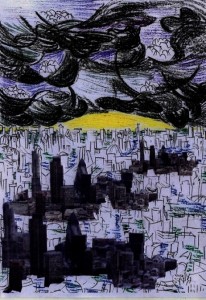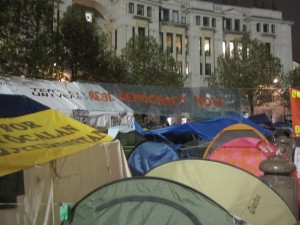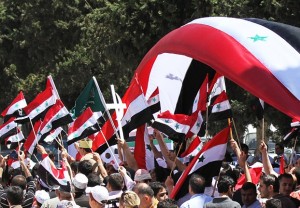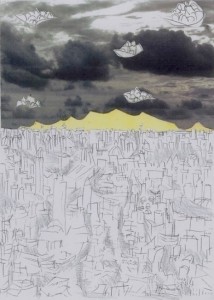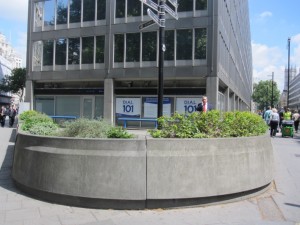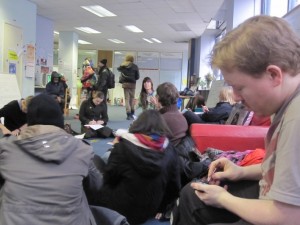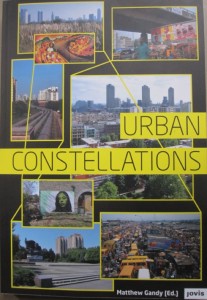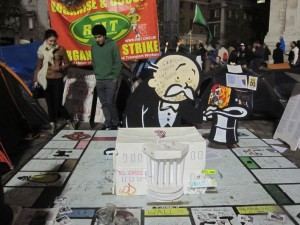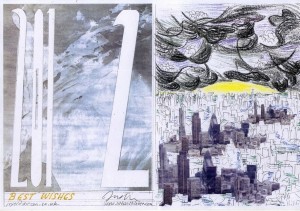OC 42: Open City – Open Mind
At a crossroads
For reasons unexplained, I have always marked the arbitrary change in time, the passage from one western calendar year to the next, with a message to my trans-spatial diaspora of family, friends and colleagues. This lone drawing of the year is supposed to express the passage of time in a landscape of events and moods which are scanning the annual time and spawning pointers to the future.
This year cities, my prime professional concern and personal passion, have been the scene of tremendous social protestations. Ordinary people have occupied the public realm, the places they believe to own as citizens as of right.
There they expressed their outrage against oppression, against injustice to themselves, their livelihood, their freedom of expression, their share of the city.
During the Arab Spring http://www.sourcewatch.org/index.php?title=Arab_Spring and other uprisings many protesters risked and lost their lives, and many more got hurt physically and mentally by the violence with which their claims were countered.
Dark future?
These events were to populate the image of my new year greetings. When I started drawing I realised that the outcome was very dark and I included a horizon with some light. Still, was even greyness appropriate for good wishes of a better future?
Or was it safer to resort to a more abstract, less charged message with simple numbers?
Never in my lifetime has the urban future seemed more at a crossroads between a place of oppression, domination, violence and social divide and its counterpart of peaceful co-habitation between multiplying diversity and distinctiveness. What will it be? Closed fortresses protecting the great and the good, or open cities welcoming all, offering space for creativity and encounter, innovation and industriousness, pleasure and compassion?
What would these urban futures have in common? Ambition – of the powerful in one scenario, of aspiring citizens in the other; wellbeing – of the rich as opposed to the urban population at large? Safety – secured by surveillance with mounting techno-military paraphernalia, or through individual rights and responsibilities and collective care? ‘Survival of the fittest’, ‘the hard working families’, ‘the deserving poor’, in contrast to destitution of the idle, the suspect foreigner, the undesired and undesirable? Freedom and prosperity – ensured by money and privilege or as a human right and, in the era of rapid urbanisation, as the right to the city?
Will future urban life comprise agitation (by groups like Tinag: This Is Not A Gateway http://www.thisisnotagateway.net/ (see previous posts), or Bank of Ideas http://www.bankofideas.org.uk/ ) by what the establishment perceives as anarchists and trouble makers to be squashed by authoritarian intervention, or will it experience a new dawn emerging from negotiations and arguments among alternatives whose common ground is the need to get away from the current system and its recurrent and unavoidable crises which are increasingly destroying the livelihood of people worldwide?
Uncertain urban futures
Much has been written and will be written about the urban future, perhaps an indication that nothing may ever be cut in stone (e.g. Preparing for the urban future, global pressures and local forces. Allison M Garland, Blair A Rule, Joseph S Tulchin (eds) John Hopkins University Press 2011). Another way of grasping urbanity is to resort to a wide range of perceptions (e.g. Urban Constellations. Matthew Gandy (ed). Jovis 2011).
Beyond writing and understanding, will the many ground swell feelings in cities come to nought, just as those of 1968 which so often ended in reactionary backlashes and leaving very few lasting improvements of urban society? Will the Occupy movement http://occupylsx.org/ as a self-appointed worldwide protest manifestation have the conviction and resilience to agree besides broad humanitarian principles on an urban strategy of change and engage a dialogue with the mainstream powers to obtain compromises towards more humane urban transformations?
Looking at the Localism Act recently adopted by parliament in the UK http://www.legislation.gov.uk/ukpga/2011/20/contents/enacted – by the way with Scottish votes on something which has force in England only – more spatial justice looks unlikely. The fig leaf of a single bite at neighbourhood planning, including by non elected businesses, will fool none of those who claim a right to the public realm.
Thus, my compromise may have to include two drawings, one dark, one non committal and abstract, arguably reflecting the contradictory and ambiguous urban condition.

